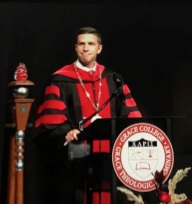
“A Piece of My Mind”
December 2022 Newsletter
Advancing Christian Faith and Values,
Defending Religious Liberty for All,
Supporting Civility and the Common Good
through Preaching, Teaching, Writing,
Activism and Reasoned Conversations


Mary and Elizabeth
My soul doth magnify the Lord,
And my spirit hath rejoiced in God my Savior.
For he hath regarded the low estate of his handmaiden:
for, behold, from henceforth all generations shall call me blessed.
For he that is mighty hath done to me great things;
and holy is his name.
And his mercy is on them that fear him
from generation to generation.
– Mary’s Song “The Magnificat” (Luke 1: 46-50 KJV)
 M“O Come Let Us Adore Him!”
M“O Come Let Us Adore Him!”
F– Worship at the Birth of Jesus
(10th and Final Essay on Worship for 2022)
“Pastor Don, why doesn’t our church have a Christmas Eve service?”
“I’m always trying to come up with new ideas but I have two problems. One, half my ideas are no good. Two, I don’t know which half!” I shared this thought several times over the years with church leadership and a couple of times in sermons.
So it was with Christmas Eve services for many years. “Pastor Don, why doesn’t our church have a Christmas Eve service? I’d really like to spend this time with my own church family!” – from a High School girl, devout and active in our church. My standard answer drawn, I thought, from many years of experience: “Our church just isn’t much into special services.”
But one year I finally gave it a try and we had our first Christmas Eve service.
The church was absolutely packed, which for us would be over 300. Good riddance to my wrong idea about Christmas Eve services! Since then, we’ve increased to two and then three services.
People really love to sing at Christmas time. They really, really love to sing traditional Christmas Carols. They want to hear familiar biblical stories about the birth of Jesus. Visitors will come and come. Now I know! Christmas Eve and Easter are the two times we can still draw visitors with relative ease, even in the highly-secular communities where many of us live.
Here are some pointers for having a fine Christmas Eve experience:
1. Plan the service(s) with visitors foremost in your mind. No “in house” or unexplained terms about Christmas (like “The Incarnation”). If you focus on visitors, members will benefit too. But the opposite isn’t true.
2. Advertise as would be reasonable in your locale (our small community has a newspaper everyone gets, and I preferred a large ad in it). But remember that personal invitation by church members is the best way to bring in visitors—tried, tested, proven.
3. Keep the service under an hour. Too much of a good thing can ruin it. Better to have people wish they had sung more than wish they had gotten out sooner. Remember, it’s a busy season for many.
4. Separate the services by enough time for people to fellowship, for the worship area to be tidied up, and for parking to “turn over.” I’d recommend a one-hour break, but half an hour might work.
5. I have no opinion on whether afternoon or evening service times are better, or a mix of the two. This is a bigger issue if you have only one service.
6. Have the worship location abundantly decorated for Christmas, indoors and out. Clear and prominent signage on childcare, restrooms, worship area.
7. Sing the familiar, traditional Christmas Carols and do it with simplicity, not with a lot of flourishes or anything else that would stifle singing.
8. Don’t sing the carols in isolation from one another, but tie them in with the Christmas stories of the Bible through appropriate scripture readings.
9. Have special music, but be sure to make it impactful. Use the best talent the church has to offer. Don’t overdo it.
10. If someone can do it skillfully, have a Children’s Story with the children down front. But make it brief and interesting to the kids (the adults will love it too). If you can’t do these with ease, leave it out.
11. Soft sell the church to visitors through brief, excellent announcements and a table display. Visitors are not a captive audience. Make them feel welcome but not on the spot. Make them want to come back.
12. Don’t take an offering or, if you do, make it specific to some special seasonal ministry of care.
13. Share the Gospel in a simple, brief sermon, drawn from the biblical stories of the birth of Jesus. Invite a heart-response. But no tricks or “come forward” invitations.
14. I’m ambivalent about having everyone holding a lit candle. Check fire regulations. You can’t be too careful.
15. If you have multiple services, treat each service and those present as if it’s the only service you are having. Never refer back to a previous one.
16. Serve some hot Wassail outside after the service. The tavern next door to our church often would prepare it for us for free (and not spiked)!
17. One idea if you have multiple services: schedule one as late evening (11:00) and serve Communion at it (and see how it goes).
18. Sadly, have more-than-adequate security for the services.
If, as this year, Christmas Day falls on a Sunday, have just one service (space permitting) and include all groups and ages in it. Limit it to one hour. Consider the wisdom of whether to make it identical to the Christmas Eve services. And don’t forget—lots of Christmas Carols and scripture readings.
Christmas celebration can continue into January if Epiphany Sunday (January 8 next year) is observed. It is based on the visit of the Magi (Matthew 2).
Songs We Learn from the Stories of Jesus’ Birth
One reason the Christmas Stories induce worship is that they introduce us to God’s Holy Spirit—an essential power in genuine Christian worship.
The Holy Spirit’s presence and power enable robust, sincere singing from our hearts. A mark of the truly Spirit-filled church is its heart-felt singing to God.
“Be filled with the Spirit, speaking to one another with psalms, hymns and spiritual songs, singing and making music from your heart to the Lord.” (Ephesians 5:18-19)
No surprise, then, that the Holy Spirit inspired four songs that have become vital features of Christmas worship. And no surprise that the Gospel of Luke, which lets us know that the coming of Christ brings the era of the Holy Spirit, would have these songs for us. We know them by titles that come from the first word(s) of their text as found in the Latin Bible.
1. The “Magnificat” – Mary’s Song (Luke 1:46-55)
Mary’s Song emerges from a marvelous encounter between two, no—make that four, persons: (1) the Virgin Mary herself, (2) her relative Elizabeth, (3) Elizabeth’s unborn son John, and (4) Mary’s unborn son Jesus (1:39-45).
After Elizabeth blessed her (“Blessed is she who has believed that what the Lord said to her will be accomplished!”), Mary exclaimed:
• She, Mary, would be honored by God for her humble obedience (46-49). All generations will call her “Blessed.” The reformer John Calvin (1509-1564) said of Mary, “She deserves to be called blessed, for God has accorded her a singular distinction, to prepare his son for the world, in whom she was spiritually reborn.”
• Her son will turn the world’s values upside down (50-53). He will give mercy to those who fear him, but dismantle the proud and powerful. Mary’s words, a standing challenge to our errant status quo, should mold our understanding of God’s will for his world more than they do.
• God will remember his promises to his people and be their help (54-55).
2. The “Benedictus” – Zechariah’s Song (Luke 1:67-79)
The Christmas Story actually begins with the story of an old man named Zechariah, a priest of God favored to be the father of “John the Baptist.”
Read the fine accounts in Luke 1 of Zechariah, his wife Elizabeth, and John.
On the day baby John was circumcised (the 8th day), Zechariah brought forth the Spirit-induced song known as the “Benedictus.”
• Jesus will bring us deliverance from our spiritual enemies and enable us to delight in doing the will of God (68-75).
• John will prepare the people for the coming of the Lord (in the person of Jesus) and will bring them the knowledge of salvation through the forgiveness of their sins (76-79).
3. The “Gloria” – The Angels’ Song (Luke 2:13-14)
An angel appeared to shepherd in the fields watching their flocks at night and relayed the “good news” that the Savior was born in Bethlehem that very day. “You will find a baby wrapped in cloths and lying in a manger” (2:8-12).
A great company of the heavenly host suddenly appeared with the angel, praising God and saying the word of the “Gloria” (verse 14).
• Praise to God.
• Peace to all on whom God’s favor rests. “Goodwill to men” (King James Version) is most familiar. But the words are not universal. Not everyone accepts God’s grace, so not all enjoy the peace that grace renders. “Peace” follows “grace” often in the New Testament.
4. The “Nunc Dimittus” – Simeon’s Song (Luke 2:29-31)
Fast forward to eight days after Jesus’ birth, when Mary and Joseph brought Jesus to the Temple in Jerusalem to be circumcised. A godly Spirit-led man named Simeon had been assured by the Spirit that he would see “the Lord’s Christ” before he died. Embracing the baby Jesus in his arms, he exclaimed:
• He could now “depart in peace” for he had seen God’s salvation.
• The child will be a blessing to all people—a light of truth to Gentiles and glory to Israel.
Songs we’ve come to love that grew from the Christmas Stories
Handel’s “Messiah” tells many parts of the Christmas story. Much of it draws from texts in the Old Testament, especially from the Prophet Isaiah. I find two choruses clearly drawn from the New Testament:
• “Glory to God” (the angelic chorus of Luke 2:14). This majestic and hard-to-sing chorus follows four recitatives that sing of the appearances of the angel of the Lord and of the company of angels (2:8-13).
• “Behold the Lamb of God” rises from the cry of John the Baptist when he saw Jesus approaching to be baptized (John 1:19).
We enjoy singing many traditional Christmas Carols that link to “The Story” (several of these can fit into multiple categories):
• Mary’s Visit by the Angel and Her Song(Luke 1:26-56)
“To a Virgin Meek and Mild”
“Lo, How a Rose E’er Blooming”
• Zechariah’s Song (Luke 1:67-79)
“Come, Thou Long Expected Jesus”
“O Come, O Come, Emmanuel”
• The Birth of Jesus (Luke 2:1-7)
“Silent Night”
“Joy to the World!”
“Away in a Manger”
“What Child Is This?”
“O Little Town of Bethlehem”
“Good Christ Men, Rejoice”
“O Holy Night”
“Once in Royal David’s City”
“He Is Born, the Divine Christ Child”
“Of the Father’s Love Begotten”
“Thou Didst Leave Thy Throne”
“He Is Born”
• The Shepherds and the Angels (Luke 2:8-20)
“Hark! The Herald Angels Sing” (The greatest carol of all!)
“While Shepherds Watched Their Flocks by Night”
“Angels We Have Heard On High” (“Gloria in Excelsis Deo”)
“Go, Tell It on the Mountain”
“The First Noel”
“On Christmas Night All Christians Sing”
“Infant Holy, Infant Lowly”
“Angels from the Realms of Glory”
“God Rest Ye Merry Gentlemen”
• The Coming of the Magi (Matthew 2:1-12)
“We Three Kings”
“O Come, All Ye Faithful”
“As with Gladness Men of Old”
Some Christmas Carols look beyond the birth of Jesus to the coming of God’s Kingdom in its fullness. Isaac Watts’ “Joy to the World” (1719) proclaims, “He comes to make his blessings known, far as the curse is found…”
Similarly, a few carols move past the birth of Christ to a vision of a world with peace and justice. The Unitarian minister Edmund Sears wrote that way in
“It Came Upon a Midnight Clear” (1849). Perhaps the best-known example is the wonderful poem, “I Heard the Bells on Christmas Day” by Henry Wadsworth Longfellow (1863).
And in despair I bowed my head:
“There is no peace on earth,” I said,
“For hate is strong, and mocks the song
Of peace on earth, good will to men.”
Then pealed the bells more loud and deep:
“God is not dead, nor doth He sleep.
The wrong shall fail, the right prevail,
With peace on earth, good will to men.”
Christmas Season would be incomplete without meaningful carols that refresh our hearts with the richness of its meaning. The Spirit of God would not have given us poetry about Jesus’ birth if it did not contribute highly to our understanding of that message and our worship of “Him who came.”
So, “O come let us adore him! Christ, the Lord.” Merry Christmas!
[To Those Who Select the Songs in our Churches: All the traditional Christmas songs are in the Public Domain. So publishers have done with them as they wish. In selecting songs, we must be sure that all the words match among the various ways we share them (hymnbooks, handouts, projection, etc.). Otherwise some will sing this while others sing that.]
Religious Liberty Vigilance –
 “I consider the government of the United States as interdicted by the Constitution from inter meddling with religious institutions, their doctrines, discipline, or exercises.”
“I consider the government of the United States as interdicted by the Constitution from inter meddling with religious institutions, their doctrines, discipline, or exercises.”
– Thomas Jefferson to Samuel Miller, 1808
“Those who expect to reap the blessings of freedom must…undergo the fatigue of supporting it.” – Thomas Paine
Religious Freedom and
The “Respect for Marriage Act” (HR 8404, S 4556)
I’m passionate about religious liberty. But I need to remind myself from time to time: “I have to choose carefully which hills to fight on.”
The “Respect for Marriage Act” (RMA) with an amendment that addresses many concerns about religious liberty has passed the Senate. It now goes back to the House (because there was no amendment when the House first passed it). If passed, it goes to the President for his signature.
Simply put, here’s what the “Respect for Marriage Act” would do:
• Repeal the “Defense of Marriage Act” (1996), which defined marriage as between a man and a woman. The Supreme Court already nullified it.
• Require states to recognize same-sex marriages that were solemnized in other states. (It does not require states to allow same-sex marriages.)
• Give the Department of Justice the right to take civil action and give “harmed” individuals the right of private action when a violation of RMA is perceived to have occurred.
• Recognize a marriage “between two individuals” if it is valid in the state where it occurred. Polygamous marriage is clearly not recognized.
• As amended by the Senate it specifies that RMA does not impact religious liberty or conscience. “Nothing in this Act, or any amendment made by this Act, shall be construed to diminish or abrogate a religious liberty or conscience protection otherwise available to an individual or organization under the Constitution of the United States or Federal law.”
• As amended it would specify that non-profit religious organizations [with a list of examples] including faith-based social agencies and educational institutions are not required to provide any services or goods for the purpose of solemnizing or celebrating a marriage and cannot be subject to any civil claim or cause of action.
The above is a summary and obviously the bill is more detailed. My comments are based on the text and status of the bill as of November 29, 2022.
My observations:
1. Competent people and organizations that I respect have contrasting opinions on RMA. Some Christian legal scholars insist that the “Respect for Marriage Act” does not sufficiently protect religious faith and practice in addition to guaranteeing recognition of same-sex marriages. Others insist that religious protections, while not thorough, are quite broad in RMA.
I definitely note that RMA does not extend its protection of religion to people of faith who exercise their convictions in the secular workplace. No employee or business owner should be compelled to speak (such as through artistic work) words that support a marriage that violates his/her religion-formed conscience. If “Freedom of Speech” means anything, it means that.
However, the RMA does avoid perpetuating the error of the now-comatose “Equality Act” that would have taken away the right of people to assert the important Religious Freedom Restoration Act (RFRA) as a protection for their exercise of religious freedom in matters covered by the act. This is critical.
2. The “Respect for Marriage Act” likely represents (but didn’t create) the greatest cultural shift of my lifetime. In 1996 the U.S. Congress passed the “Defense of Marriage Act” by supermajorities (342-67 in the House, 85-14 in the Senate). It was supported and signed by President Clinton. At the time, American opposition to same-sex marriage was around 70%.
I understand that 70% of the American public now accepts same-sex marriage. In 2015 the U.S. Supreme Court (Obergefell v. Hodges) decided that same-sex marriage was a constitutionally guaranteed right. It is strongly supported by President Biden. These are simple facts, not opinions.
3. Yes, the church has a definite responsibility toward the wellbeing of society. Early Christianity did, after all, strongly oppose infanticide as practiced in its culture. But the church can be under no sense of illusion or compulsion that it must make society conform to all its moral positions. In other words, it must choose what hills to fight on. If we keep the tension between what we work to accomplish in this age versus what we hope for when Christ’s Kingdom is realized we will avoid the (phony) charge that we are “Christian nationalists” out to impose our religion on the reluctant. Keeping this tension also means we can settle for “half of a pie” at times. It recognizes that the process of legislation involves tradeoffs.
As a Christian social activist I have weighed these developments carefully and thought about what the role and responsibilities of Christian churches, faith communities and individuals are to be in our present cultural environment.
I ponder the words of the Apostle Paul: “What business is it of mine to judge those outside the church? Are you not to judge those inside [answer: ‘Yes!’]? God will judge those outside” (1 Corinthians 5:12-13). And God’s judgments are fair and true.
My decision is to double-down on support for religious liberty. RMA does not establish the right to same-sex marriage. That has already been done. Without the “Religious Liberty and Conscience” exemptions RMA would be flawed by its onesidedness. I have decided I will without great enthusiasm support RMA because of the religious liberty amendment which, though incomplete, preserves RFRA and is needed.
How Essential Is Truth?
“A world of truth is a world of trust, and vice versa. In it, there is something larger than individuals seeking their own interest. Where there is honesty—truth and truthfulness—there tends to be law, order, and prosperity.
A respect for truth is essential for authority, collaborative endeavor, and human graciousness… Where truth dies, there trust dies.”
– Rabbi Jonathan Sacks, Morality—Restoring the Common Good in Divided times (Basic Books, 2020)
Message of the Month
This Thanksgiving – Thankful for Family, God’s Plan for Passing the Faith to Future Generations
My wife and I have been listening to the Book of Deuteronomy. Again and again, I hear how important it is (1) to keep in touch with history and (2) to pass the faith and its values on to future generations.
A man once told me, “It’s not my job to teach religion to my children. That’s the Church’s job.” The latter part is true; the first part totally false. The church is there to support the parents’ efforts and nurture the faith of families.
And Moses declared, “Hear, O Israel: Lord our God, the Lord is one. Love the Lord your God with all your heart and with all your soul and with all your strength. These commandments that I give you today are to be on your hearts. Impress them on your children. Talk about them when you sit at home and when you walk along the road, when you lie down and when you get up. Tie them as symbols on your hands and bind them on your foreheads. Write them on the doorframes of your houses and on your gates.” (Deuteronomy 6:4-9)
“Teach them [God’s instructions] to your children, talking about them when you sit at home and when you walk along the road, when you lie down and when you get up.” (Deuteronomy 11:19)

Message on the Bottle:
PAIRS WELL WITH
Officiant duties
“Will You Marry Us?”
The lesson is that parental love for God and the beliefs, values and commandments that come from God’s Word are to be conveyed through all the experiences of life. Bible reading at the table is important; how the parents live out the lessons of their faith day by day is all-important.
This Thanksgiving was especially poignant for me. My granddaughter Rylee (our first) recently became engaged to Justin, a fine young man. At our Thanksgiving gathering they, well, let the picture tell the story!
 My Alma Maters, Grace College (B.A., 1966) and Grace Theological Seminary (M.Div., 1969) in Winona Lake, Indiana have installed DR. DREW FLAMM, Ph.D. to be their seventh president.
My Alma Maters, Grace College (B.A., 1966) and Grace Theological Seminary (M.Div., 1969) in Winona Lake, Indiana have installed DR. DREW FLAMM, Ph.D. to be their seventh president.
A high-energy leader, at 40 one of the youngest college presidents in the U.S., he brings experience, dedication and “can do” motivation to his role. His inauguration into his new role marks a generational change but not a change in energetic leadership as he succeeds Dr. Bill Katip, a “pedal to the metal” president if there ever was one. Drew makes “Knowing Christ and making Christ known” (the motto of the college and seminary) his clear, Christ-centered theme.
The college is remarkably different from when I arrived as a student in 1962 to become part of a student body a fraction the size of my high school graduating class. Grace is known now for its innovations, many achievements, strong enrollment, community engagement, a fine campus and more. I wish and pray the best to the new president and I’m proud to be an alumnus twice over!
www.donaldshoemakerministries.com
Don has been a member of the clergy in the Long Beach, California area since 1970. He now serves as Pastor Emeritus of Grace Community Church of Seal Beach (where he was senior pastor 1984-2012) and as Senior Chaplain of the Seal Beach Police Department (2001+). He previously was an assistant professor of Biblical Studies at Biola University (1976-84) and chaired the Social Concerns Committee in the Fellowship of Grace Brethren Churches from 1985 to 2019.
His graduate work includes a Master of Divinity from Grace Theological Seminary, a Master of Theology from Fuller Theological Seminary with a concentration in Christian ethics, and a Doctor of Ministry from American Baptist Seminary of the West (now Berkeley School of Theology) with a concentration on the Charismatic Movement. His law school studies included a course on the First Amendment. He and his wife Mary have been married for over 56 years. They have two children and six grandchildren.
© 2022 Donald P. Shoemaker

